high beam LEXUS RCF 2019 Owners Manual
[x] Cancel search | Manufacturer: LEXUS, Model Year: 2019, Model line: RCF, Model: LEXUS RCF 2019Pages: 636, PDF Size: 12.48 MB
Page 3 of 636

3 1
876432
9
RC F_U 53-1. Key information
Keys .................................................. 140
3-2. Opening, closing and
locking the doors and
trunk
Doors ................................................145
Trunk .................................................. 151
Smart access system with
push-button start.......................156
3-3. Adjusting the seats
Front seats ....................................... 161
Rear seats .......................................164
Power easy access system/
driving position memory/
memory recall function ..........166
Head restraints .............................. 171
3-4. Adjusting the steering
wheel and mirrors
Steering wheel .............................. 174
Inside rear view mirror .............. 176
Outside rear view mirrors .......178
3-5. Opening, closing the
windows and moon roof
Power windows ........................... 182
Moon roof ...................................... 186 4-1. Before driving
Driving the vehicle ......................192
Cargo and luggage ....................201
Vehicle load limits ..................... 204
Trailer towing .............................. 205
Dinghy towing ............................. 206
4-2. Driving procedures
Engine (ignition) switch ........... 207
Automatic transmission ............213
Turn signal lever ........................... 221
Parking brake .............................. 222
ASC
(Active Sound Control)
(RC350/RC300) ................ 223
ASC
(Active Sound Control)
(RC F) .......................................... 224
4-3. Operating the lights and
wipers
Headlight switch ........................ 225
Automatic High Beam............. 228
Fog light switch ........................... 232
Windshield wipers and
washer ......................................... 233
4-4. Refueling
Opening the fuel tank cap ....... 2413
Operation of each
component 4
Driving
Page 21 of 636

21Pictorial index
RC F_U Automatic High Beam switch . . . . . . . . . . . . . . . . . . . . . . . . . . . . . . . . . . . . . . P. 228
Windshield wiper de-icer switch
* . . . . . . . . . . . . . . . . . . . . . . . . . . . . . . . . . P. 339
Active rear wing switch . . . . . . . . . . . . . . . . . . . . . . . . . . . . . . . . . . . . . . . . . . . . .P. 307
Odometer/trip meter/trip meter reset button . . . . . . . . . . . . . . . . P. 107, 120
Instrument panel light control sw itches . . . . . . . . . . . . . . . . . . . . . . . . . P. 94, 100
Intuitive parking assist switch
* . . . . . . . . . . . . . . . . . . . . . . . . . . . . . . . . . . . . . P. 280
BSM (Blind Spot Monitor) main switch
* . . . . . . . . . . . . . . . . . . . . . . . . . . . P. 290
ASC switch
* . . . . . . . . . . . . . . . . . . . . . . . . . . . . . . . . . . . . . . . . . . . . . . . . . . . . . . . . P. 223
* : If equipped1
2
3
4
5
6
7
8
Page 87 of 636
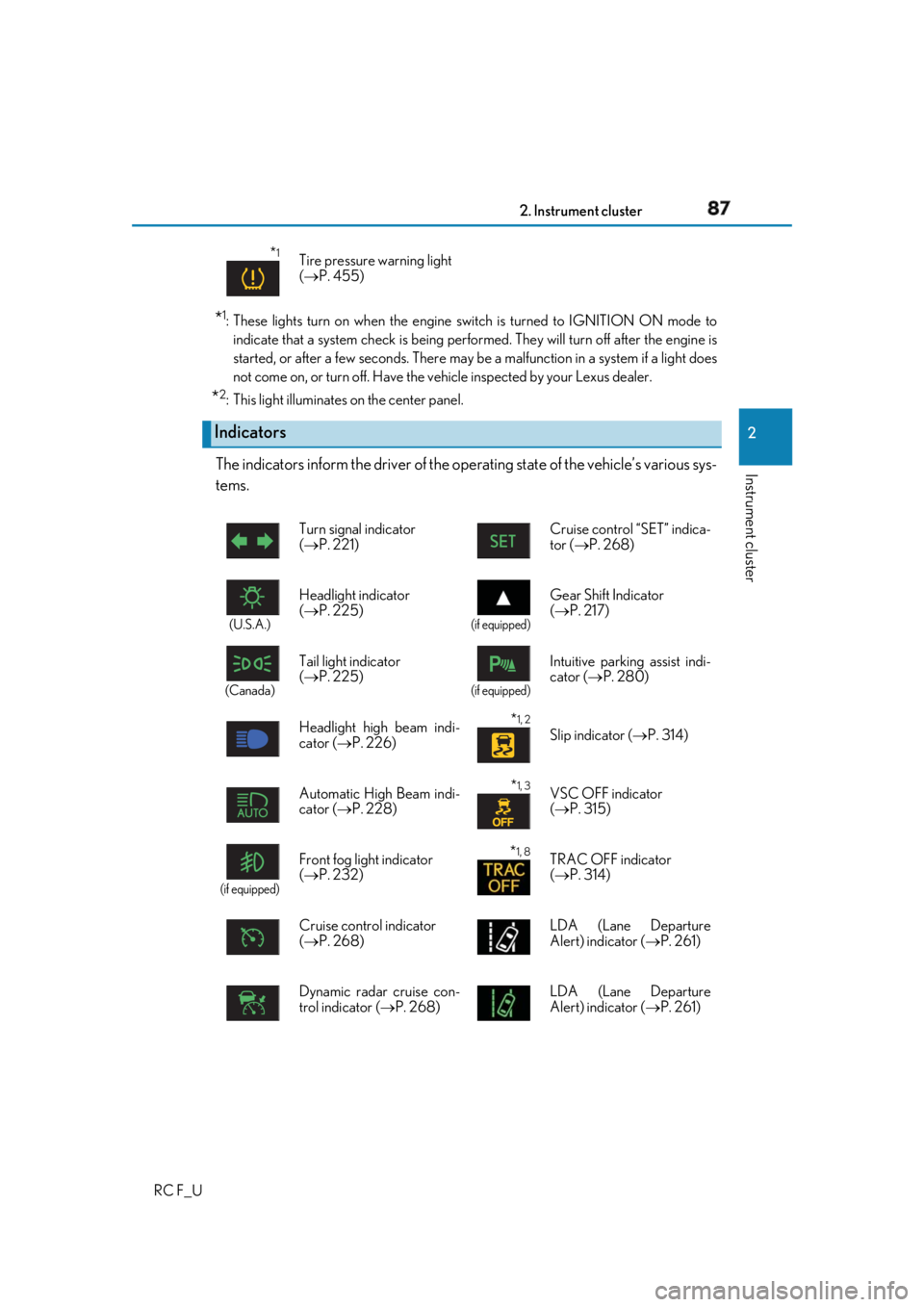
872. Instrument cluster
2
Instrument cluster
RC F_U * 1
: These lights turn on when the engine switch is turned to IGNITION ON mode to
indicate that a system check is being performed. They will turn off after the engine is
started, or after a few seconds. There may be a malfunction in a sy stem if a light does
not come on, or turn off. Have the ve hicle inspected by your Lexus dealer.
* 2
: This light illuminates on the center panel.
The indicators inform the driver of the op erating state of the vehicle’s various sys-
tems. * 1
Tire pressure warning light
( P. 455)
Indicators Turn signal indicator
( P. 221) Cruise control “SET” indica-
tor ( P. 268)
(U.S.A.)
Headlight indicator
( P. 225) (if equipped)
Gear Shift Indicator
( P. 217)
(Canada)
Tail light indicator
( P. 225)
(if equipped)
Intuitive parkin g assist indi-
cator ( P. 280)
Headlight high beam indi-
cator ( P. 226)
* 1, 2
Slip indicator ( P. 314)
Automatic High Beam indi-
cator ( P. 228) * 1, 3
VSC OFF indicator
( P. 315)
(if equipped)
Front fog light indicator
( P. 232) * 1, 8
TRAC OFF indicator
( P. 314)
Cruise control indicator
( P. 268) LDA (Lane Departure
Alert) indicator ( P. 261)
Dynamic radar cruise con-
trol indicator ( P. 268) LDA (Lane Departure
Alert) indicator ( P. 261)
Page 191 of 636

191
Driving
4
RC F_U 4-1. Before driving
Driving the vehicle ...................... 192
Cargo and luggage .................... 201
Vehicle load limits ......................204
Trailer towing .............................. 205
Dinghy towing ............................ 206
4-2. Driving procedures
Engine (ignition) switch ...........207
Automatic transmission............ 213
Turn signal lever........................... 221
Parking brake .............................. 222
ASC
(Active Sound Control)
(RC350/RC300) .................223
ASC
(Active Sound Control)
(RC F)........................................... 224
4-3. Operating the lights and
wipers
Headlight switch .........................225
Automatic High Beam .............228
Fog light switch ...........................232
Windshield wipers and
washer..........................................233 4-4. Refueling
Opening the fuel tank cap .......241
4-5. Using the driving support
systems
Lexus Safety System+ .............. 245
PCS
(Pre-Collision System) .........250
LDA
(Lane Departure Alert
with steering control) ..............261
Dynamic radar cruise
control ......................................... 268
Intuitive parking assist ..............280
BSM
(Blind Spot Moni tor)..............290
• BSM function ......................... 293
• RCTA function...................... 297
Driving mode select
switch ............................................ 301
Active rear wing ......................... 307
TVD
(Torque Vectoring
Differential) ................................. 310
Driving assist systems ............... 312
4-6. Driving tips
Winter driving tips .....................320
Page 226 of 636
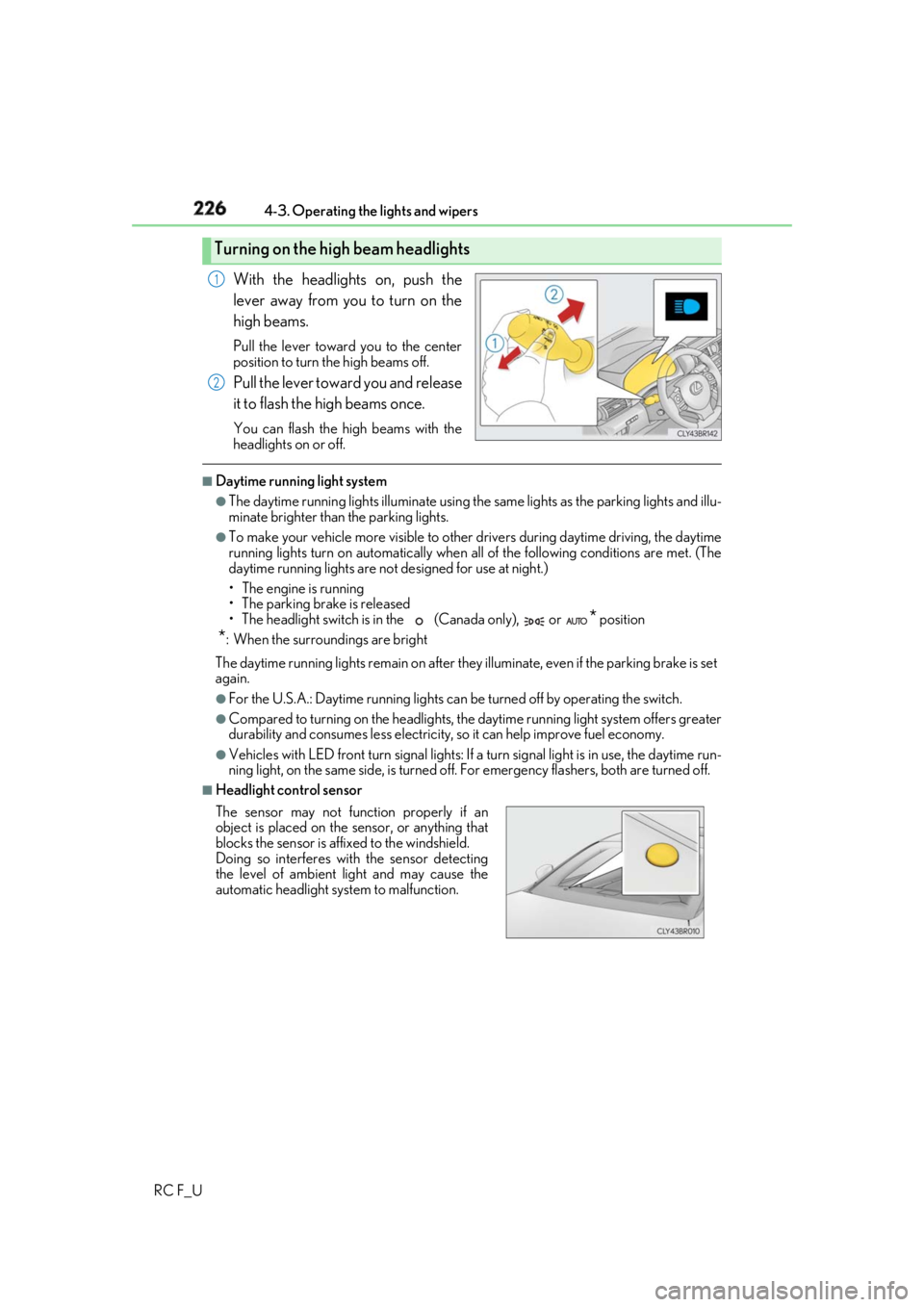
226 4-3. Operating the lights and wipers
RC F_U With the headlights on, push the
lever away from you to turn on the
high beams. Pull the lever toward you to the center
position to turn the high beams off.
Pull the lever toward you and release
it to flash the high beams once. You can flash the high beams with the
headlights on or off. ■
Daytime running light system ●
The daytime running lights illuminate using th e same lights as the parking lights and illu-
minate brighter than the parking lights. ●
To make your vehicle more visible to other drivers during daytime driving, the daytime
running lights turn on automatically when a ll of the following conditions are met. (The
daytime running lights are not designed for use at night.)
• The engine is running
• The parking brake is released
• The headlight switch is in the (Canada only), or
* position
* : When the surroundings are bright
The daytime running lights remain on after they illuminate, even if the parking brake is set
again. ●
For the U.S.A.: Daytime running lights can be turned off by operating the switch.●
Compared to turning on the headlights, the daytime running light system offers greater
durability and consumes less electricity, so it can help improve fuel economy.●
Vehicles with LED front turn signal lights: If a turn signal light is in use, the daytime run-
ning light, on the same side, is turned off. For emergency flashers, both are turned off. ■
Headlight control sensorTurning on the high beam headlights 1
2
The sensor may not function properly if an
object is placed on the sensor, or anything that
blocks the sensor is affixed to the windshield.
Doing so interferes with the sensor detecting
the level of ambient li ght and may cause the
automatic headlight system to malfunction.
Page 228 of 636
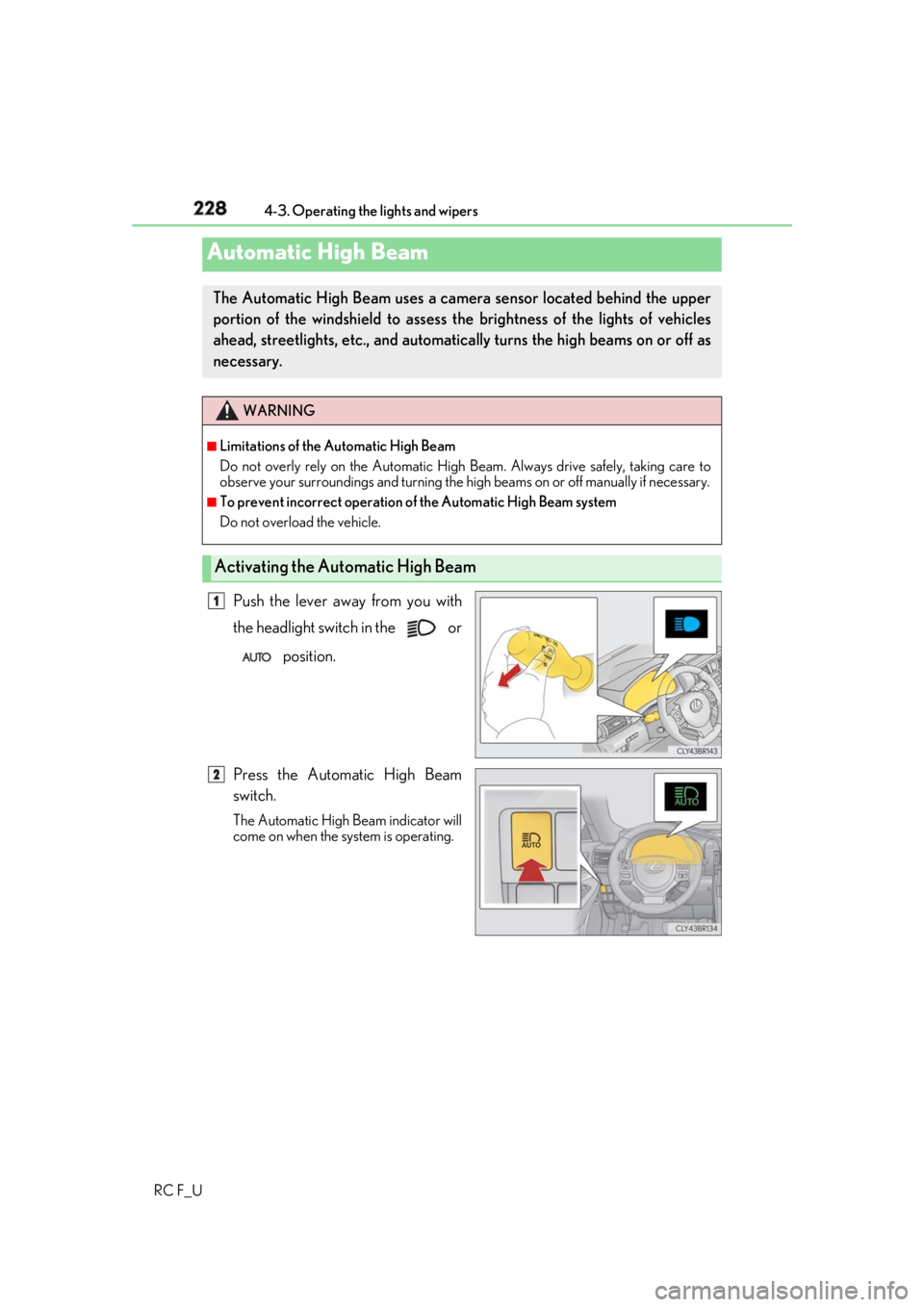
228 4-3. Operating the lights and wipers
RC F_U Push the lever away from you with
the headlight switch in the or
position.
Press the Automatic High Beam
switch. The Automatic High Beam indicator will
come on when the system is operating.Automatic High Beam The Automatic High Beam uses a came ra sensor located behind the upper
portion of the windshield to assess the brightness of the lights of vehicles
ahead, streetlights, etc., and automatica lly turns the high beams on or off as
necessary. WARNING ■
Limitations of the Automatic High Beam
Do not overly rely on the Automatic High Beam. Always drive safely, taking care to
observe your surroundings and turning the hi gh beams on or off ma nually if necessary.■
To prevent incorrect operation of the Automatic High Beam system
Do not overload the vehicle.
Activating the Automatic High Beam 1
2
Page 229 of 636
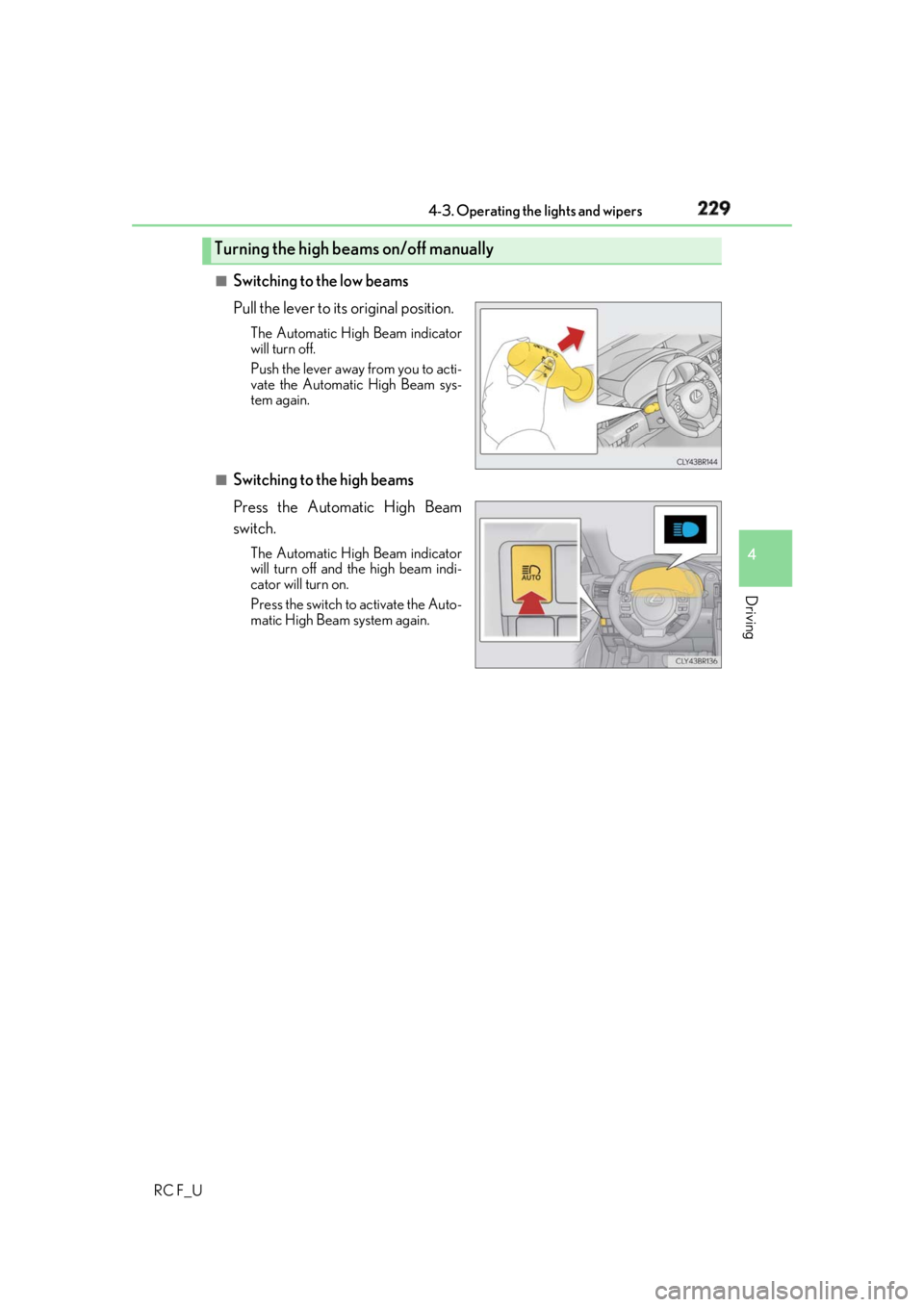
2294-3. Operating the lights and wipers
4
Driving
RC F_U ■
Switching to the low beams
Pull the lever to its original position. The Automatic High Beam indicator
will turn off.
Push the lever away from you to acti-
vate the Automatic High Beam sys-
tem again.
■
Switching to the high beams
Press the Automatic High Beam
switch. The Automatic High Beam indicator
will turn off and the high beam indi-
cator will turn on.
Press the switch to activate the Auto-
matic High Beam system again.Turning the high beams on/off manually
Page 230 of 636

230 4-3. Operating the lights and wipers
RC F_U ■
Conditions to turn the high beams on/off automatically●
When all of the following conditions are met, the high beams will be turned on automat-
ically (after approximately 1 second):
• The vehicle speed is approximately 21 mph (34 km/h) or more.
• The area ahead of the vehicle is dark.
• There are no vehicles ahead with headlights or tail lights turned on.
• There are few streetlights on the road ahead. ●
If any of the following condit ions is met, the high beams will turn off automatically:
• The vehicle speed is below ap proximately 17 mph (27 km/h).
• The area ahead of the vehicle is not dark.
• Vehicles ahead have th eir headlights or tail lights turned on.
• There are many streetlights on the road ahead. ■
Camera sensor detection information ●
The high beams may not be automatically turned off in the following situations:
• When a vehicle suddenly appears from around a curve
• When the vehicle is cut in front of by another vehicle
• When vehicles ahead cannot be detected du e to repeated curves , road dividers or
roadside trees
• When vehicles ahead appear in a faraway lane on a wide road
• When the lights of vehicles ahead are not on ●
The high beams may be turned off if a vehicl e ahead that is using fog lights without its
headlights turned on is detected. ●
House lights, street lights, traffic signals, and illuminated billboards or signs and other
reflective objects may cause the high beams to change to the low beams, or the low
beams to remain on. ●
The following factors may affect the amount of time taken for the high beams to turn on
or off:
• The brightness of the headlights, fog lights, and tail lights of vehicles ahead
• The movement and direction of vehicles ahead
• When a vehicle ahead only has operational lights on one side
• When a vehicle ahead is a two-wheeled vehicle
• The condition of the road (gradient, cu rve, condition of the road surface, etc.)
• The number of passengers and amount of luggage in the vehicle ●
The high beams may turn on or off unexpectedly.
Page 231 of 636

2314-3. Operating the lights and wipers
4
Driving
RC F_U ●
Bicycles or similar vehicles may not be detected. ●
In the following situations the system may not be able to correctly detect the surround-
ing brightness level. This may cause the lo w beams to remain on or the high beams to
flash or dazzle pedestrians or vehicles ahead. In such a case, it is necessary to manually
switch between the high and low beams.
• When driving in inclement weather (heavy ra in, snow, fog, sandstorms, etc.)
• When the windshield is obscured by fog, mist, ice, dirt, etc.
• When the windshield is cracked or damaged
• When the camera sensor is deformed or dirty
• When the temperature of the camera sensor is extremely high
• When the surrounding brightness level is equal to that of he adlights, tail lights or fog
lights
• When headlights or tail lights of vehicles ahead are turned off, dirty, changing color,
or not aimed properly
• When the vehicle is hit by water, snow, dust, etc. from a preceding vehicle
• When driving through an area of intermittently changi ng brightness and darkness
• When frequently and repeated ly driving ascendin g/descending roads, or roads with
rough, bumpy or uneven surfaces (such as stone-paved roads, gravel roads, etc.)
• When frequently and repeatedly taking curves or driving on a winding road
• When there is a highly reflective object ahea d of the vehicle, such as a sign or mirror
• When the back of a preceding vehicle is highly reflective, such as a container on a
truck
• When the vehicle's headlights are damaged or dirty, or are not aimed properly
• When the vehicle is listing or titling due to a flat tire, a trailer being towed, etc.
• When the headlights are changed between the high beams and low beams repeat-
edly in an abnormal manner
• When the driver believes that the high beams may be flashing or dazzling pedestri-
ans or other drivers■
Temporarily lowering sensor sensitivity
The sensitivity of the sensor can be temporarily lowered.
Turn the engine switch off while the following conditions are met.
• The headlight switch is in or .
• The headlight switch lever is in high beam position.
• Automatic High Beam switch is on.
Turn the engine switch to IGNITION ON mode.
Within 30 seconds after , re peat pulling the he adlight switch lever to the original
position then pushing it to the high beam position quickly 10 times, then leave the lever
in high beam position.
If the sensitivity is changed, the Automatic High Beam indicator is turn on and off 3
times.
Automatic High Beam (head lights) may turn on even the vehicle is stopped.1
2
3 2
4
Page 245 of 636
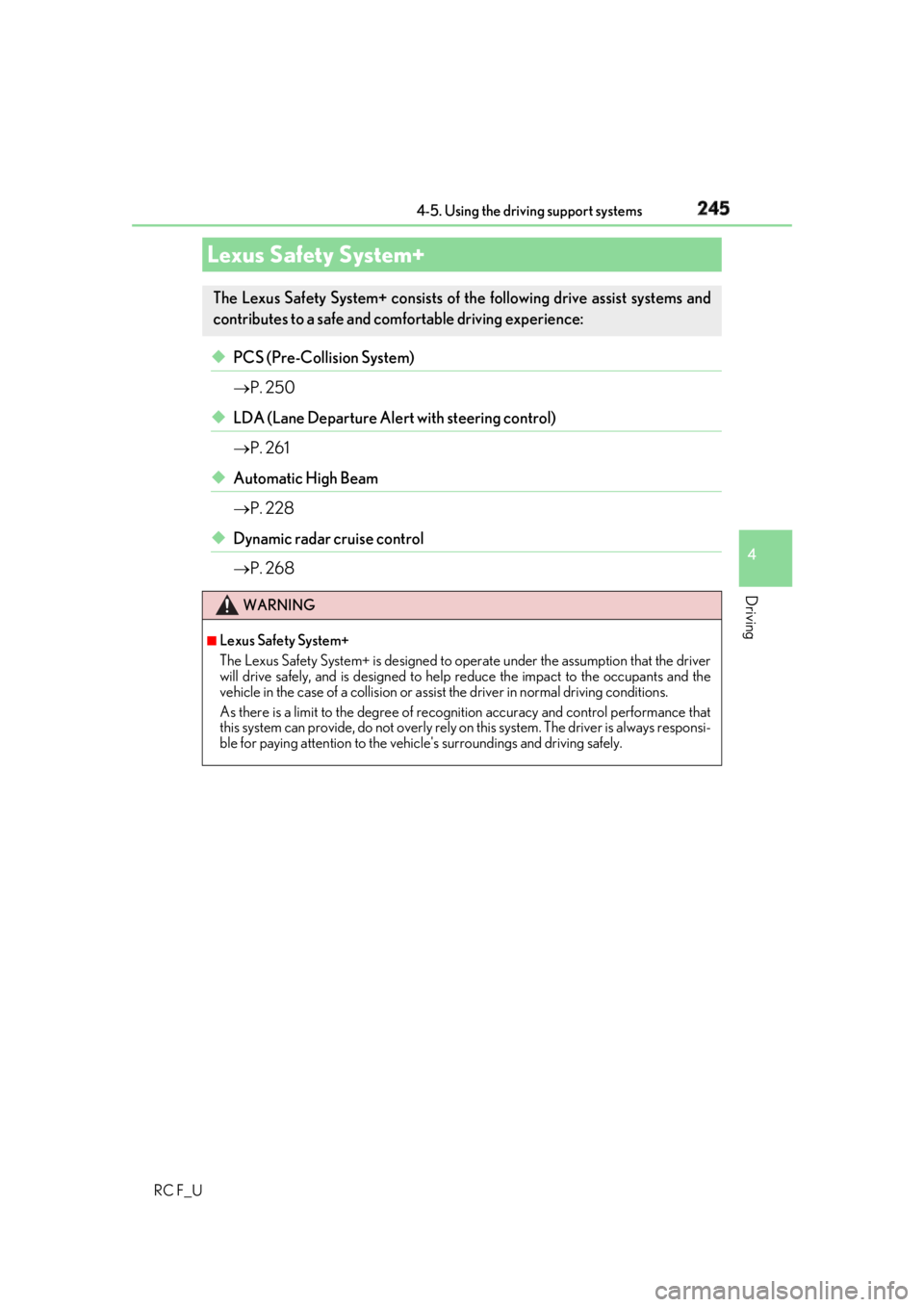
245
4
Driving
RC F_U 4-5. Using the driving support systems
◆ PCS (Pre-Collision System)
P. 250
◆ LDA (Lane Departure Alert with steering control)
P. 261
◆ Automatic High Beam
P. 228
◆ Dynamic radar cruise control
P. 268Lexus Safety System+ The Lexus Safety System+ consists of the following drive assist systems and
contributes to a safe and comfo rtable driving experience:
WARNING ■
Lexus Safety System+
The Lexus Safety System+ is designed to operate under the assumption that the driver
will drive safely, and is design ed to help reduce the impa ct to the occupants and the
vehicle in the case of a collision or assist the driver in normal driving conditions.
As there is a limit to the degree of reco gnition accuracy and control performance that
this system can provide, do not overly rely on this system. The driver is always responsi-
ble for paying attention to the vehicl e's surroundings and driving safely.